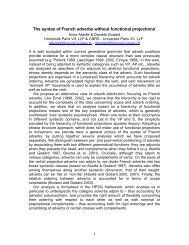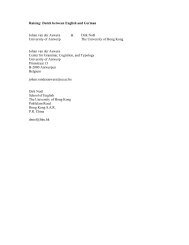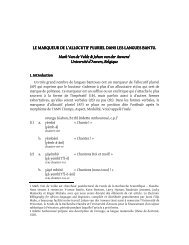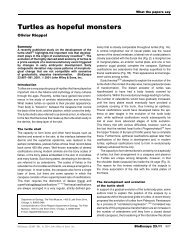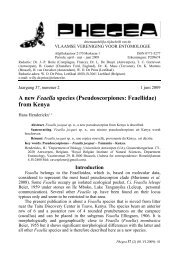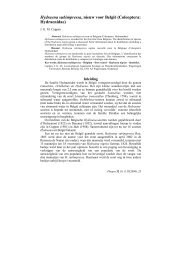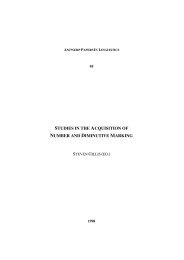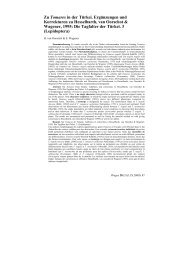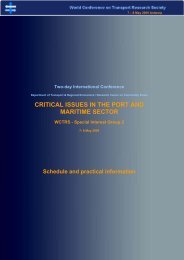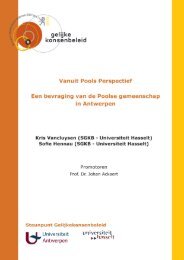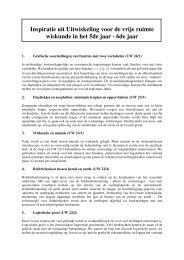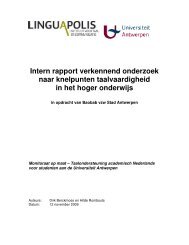Theodor2005.pdf
Theodor2005.pdf
Theodor2005.pdf
You also want an ePaper? Increase the reach of your titles
YUMPU automatically turns print PDFs into web optimized ePapers that Google loves.
176 Theodor and Foss<br />
of maxillary embrasure pits (character 51) and a thick involucrum in the ectotympanic<br />
(character 79).<br />
One of the most interesting results of our analysis is the relationship of anthracotheres<br />
with the clade of suoids, cebochoerids, and entelodonts, rather than as the sister-taxon to<br />
hippopotamids, while the choeropotamids [including haplobunodontids, following Hooker<br />
and Weidmann (2000) and Hooker and Thomas (2001)] cluster with the dichobunids and<br />
Helohyus. While the support values for the suoid portion of the tree are relatively low,<br />
we found no support for a sister-taxon relationship between the anthracotheres and the<br />
hippopotamids.<br />
DISCUSSION<br />
The jaws of Cebochoerus and Acotherulum show a distinct difference in morphology<br />
between the third and fourth deciduous premolars. The dp4 of the cebochoerids examined<br />
(Figs. 1 and 2) displays the 6-cusped morphology typical of artiodactyl taxa whose dp4<br />
is described (Luckett and Hong, 1998). The adult molars that are erupted posterior to dp4<br />
are blunt-cusped and characteristic of other early artiodactyls. In the adult premolars of<br />
cebochoerids, the p4 lacks a paraconid entirely, and none of the premolars show any trace of<br />
the unusual juvenile morphology. However, the morphology of the dp2-3 of cebochoerids is<br />
highly unusual among artiodactyls, and resembles that of basilosaurid cetacean deciduous<br />
and adult teeth (Fig. 3(a)), and is similar to the description of the adult upper teeth of Georgiacetus<br />
(Hulbert et al., 1998). The cusps in cebochoerids are arranged along a midline<br />
mesiodistal crest, giving the teeth the appearance of serrated triangles, although they retain<br />
small talonid basins as in other artiodactyls (Fig. 1(b)). In contrast, the third deciduous<br />
premolars of two relatively primitive Eocene artiodactyls, Diacodexis (UM 79924) and<br />
Antiacodon (CM 53969; Fig. 3(b)), show a more tribosphenic pattern, with large para- and<br />
protoconids and a long distal crest with a small, weakly basined talonid and a robust ectostylid,<br />
and lacking a metaconid and accessory cuspids. The anterior deciduous premolars<br />
of cebochoerids do not resemble those of the hippopotamids, which also lack any accessory<br />
cuspids on dp2-3.<br />
The second and third deciduous premolars of basilosaurid cetaceans have more, betterdifferentiated<br />
denticles than those in cebochoerids, and the cusp homologies in the former<br />
taxa are difficult to assess. In certain fossil cetaceans, dp4 is similar to the anterior deciduous<br />
premolars and does not resemble that of any artiodactyl (Uhen, 2000). Deciduous<br />
teeth of Dorudon show no sign of the talonid basin found in the cebochoerids (Uhen,<br />
2000, 2004). The deciduous teeth described for Pakicetus (Gingerich and Russell, 1990;<br />
Thewissen and Hussain, 1998) are much less complex than those of basilosaurids and<br />
dorudontids, lacking the aforementioned accessory denticles. Thus, the described deciduous<br />
teeth of pakicetids (Thewissen and Hussain, 1998) do not resemble those of<br />
cebochoerids.<br />
Pearson (1927), in detailed descriptions of the basicrania of early artiodactyls, compared<br />
cebochoerids with anthracotheres and hippos, and suggested that cebochoerids might<br />
represent an ancestor to hippopotamids and anthracotheres. Colbert (1935), preferred an<br />
anthracotherid ancestry for hippos, an interpretation that has dominated in the literature,<br />
although palaeochoerids (formerly referred to as Old World tayassuids) have also been<br />
suggested as potential ancestors for hippos (Pickford, 1983). The features of cebochoerid



